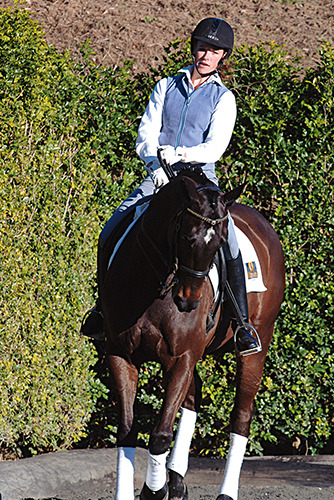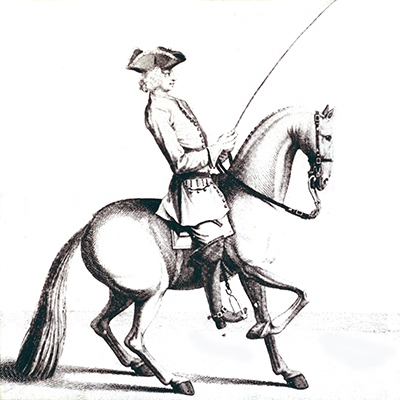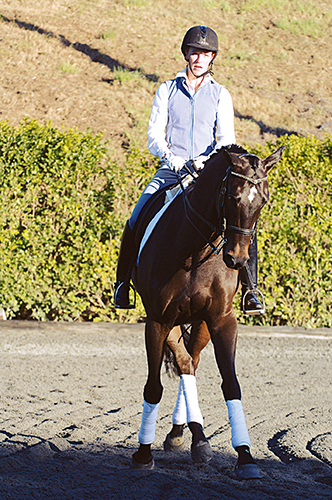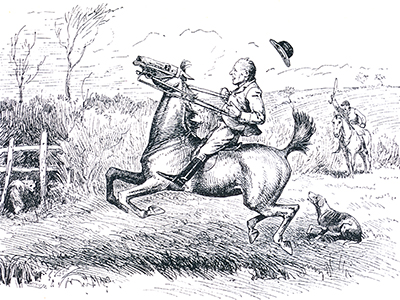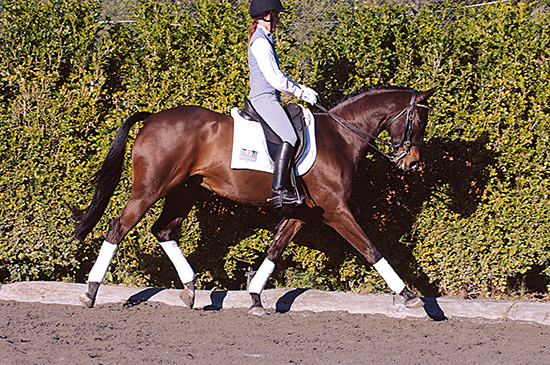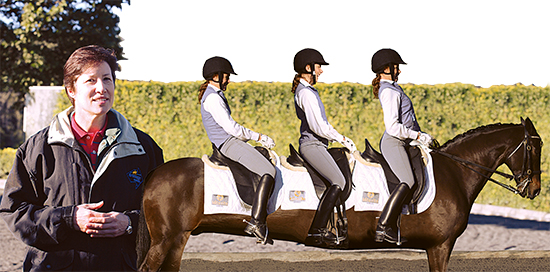 A discussion with Ricky MacMillan
A discussion with Ricky MacMillan
Ricky MacMillan was not only a very successful dressage rider for Australia, she is also one of our most thoughtful, and she has used her time training with some of Europe’s best trainers to develop a sophisticated appreciation of the dressage principles. Ricky is also a gifted coach, and has travelled widely helping dressage riders all over Australia.
One of Ricky’s FEI level riders, told me that she found it helpful when Ricky suggested to her that she get her weight really back in the saddle – even if it meant her knees were forward, almost like a chair seat – to get anchored in the saddle and with the movement, before re-aligning her body…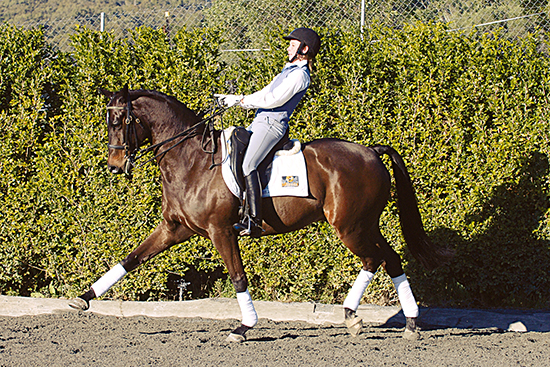
As usual Ricky’s suggestion was carefully tailored to the particular rider she was working with at that particular moment…
“As a coach I try to find the right way to communicate my ideas to the rider and I think every rider has different strengths and weaknesses and different areas that they need to work on. For someone like Lindy, she already is an amazing horse person. She knows so much about horses, and I think that is the first step for any rider. Just getting in the saddle and riding – without any real knowledge of horses – to me is a very strange way to get started. But once you do have some of that knowledge, the second step is to find balance.”
“It is only the second step but it is a step that is so important that even the best riders in the world need to keep working on achieving their balance.”
“For me, balance is being able to sit alone on the horse without using the hands and the legs to hold yourself on. To find a way to align your centre of gravity with the horse’s centre of gravity, just by being there. For some riders the posture of their hips and torso is going to need fine tuning – and that is going to be the key to finding their balance.”
The ideal way to find this balance is to put the novice rider AND ALSO the experienced rider, on the lunge, without stirrups and without reins, but that is not always possible, particularly as I am often only coaching for a couple of days – so it is a matter of finding some way of helping the rider.
“I can remember that when I first started teaching Lindy she was riding with a little bit of an exaggerated ‘S’ shape in her spine. I hope Lindy doesn’t mind me saying this, but she might have had a very elegant concavity of her back but to me she had exaggerated that natural curvature of the spine and that was limiting her possibility to have optimal balance. I needed to help her find a way to get a better balance. Before you think about fine tuning the aids, or you think about a really deep seat, you have to have that balance.”
“To help with the balance with Lindy, we were working on the position of the torso, because that’s where the balance comes from – torso and maybe the upper legs. For Lindy to get her to tuck under behind would have been more my remedy than a chair seat. For me a chair seat is faulty – with a chair seat the knees will always come forward and always be out of balance. Having said that, sometimes in coaching it is helpful to exaggerate the opposite of what the problem is – so then the rider can discover of their own accord that that is too far the other way, but you’ve opened up more possibilities and they can re-find their balance having been on the other side of the ideal balance.”
“You can’t easily put a rider in an ideal position. Maybe when you are coaching tennis, you can position the student’s feet where you want them, you can position their hand on the racket, you can even move their arm – it’s very difficult to do that for a rider in the saddle. There are a couple of ways I’ve found to do it. I can ask the rider to get off the horse, we can work standing on the ground, or sitting on a chair, and we can discuss modifications to their position.”
“There are many factors we are dealing with. Balance can be influenced by something like the length of the stirrups – stirrups too long, knees too low, can adversely influence balance. Stiffness in the neck and a poor head position will affect balance. It’s not always a case of tuck the seat under – but in Lindy’s case that is where we concentrated. It is not an uncommon problem – this very elegant seat that reminds me of the Riddinger engravings, of the gentleman in a silk jacket with a hollow back and a lovely long leg, and a stiff appearance even in the engravings – perhaps we are a little taken by that elegant appearance, and maybe it comes from our showing days…”
“So I would like with the rider who has a little of that hollowed elegance to maybe find somewhere where the pelvis is tipped a little bit backwards – not as far as a chair seat but in that direction.”
“Sitting on a horse, we can tip our pelvis from a balanced neutral position – forwards, backwards, left and right. I often talk to riders about a clock face, and if we have that mental picture, not only could we go around – 12, 11, 10, 9, 8 – whatever – but we can also go across the clock face in any pattern we want. So yes, tucking the seat under for Lindy, that brought her knees forward, and then we had to deal with that. I’ve never had good results telling a rider put yourself here, put yourself there, it’s more a question of helping them to experience different possibilities, and through that, to find their own balance. For Lindy, tucking her seat under meant her knees came forwards, and then it was a matter of asking her not to grip with her thighs, to come a little looser with her legs, and then perhaps, finally, and only then, letting the knees come down and back.”
“I think I also got on Lindy’s horse, and changed his balance a little, and then asked Lindy to get back in the saddle, and let the horse change her position.”
And that other extreme, have you ever asked a rider to sit forward in the ‘crutch’ seat?
“That would be cruel! But while there is an extreme crutch seat that we don’t want to go near, we do want to be able to tilt our pelvis forward at times. If we are at the base of a fence, we want to unload the horse’s hindquarters. If we are riding a young horse, or a horse with a sensitive back, or a horse that is not strong – perhaps a horse that has been out of work for a time. Then those are times when we want to lighten the load on the horse’s back. When we want to make piaffe, then often we are going to want to be lighter – so there are times when we want to tilt the pelvis forward, and just as there are times when we will want to tip the pelvis backwards, if we want to really load up the horse’s hindquarters, or load its back. So while there is a balanced seat, when we talk about being effective riders and using the aids – our weight is one of those aids, so we do want to change that sitting position, but the neutral or balanced position is where we want to return to.”
“I can’t imagine riding for any length of time, too far from that balanced position – that position is the one with the least muscle tension for the rider. Not that you ever want to have slack muscles but we need to have muscles that can freely contract and relax, like in the training scale for horses, losgelassenheit, in the same way to have a balanced seat, that’s how our muscles should be working, supple muscles. The minute we are not in this balanced position, with the rider’s weight aligning relative to the horse’s weight, so that the centre of gravity is aligned, the minute we diverge from that for any period of time, then we are likely to become a burden to the horse. The minute we are using excess muscle tension, tightness, we might not necessarily annoy the horse, but it is likely we are going to be perceived by the horse as interfering more. Moving out of the balanced seat is more of an aid. We need to leave the horse alone – that is the positive result of the rider sitting in a balanced seat…”
It didn’t hurt Nicole Uphoff that she sat in a bit of a chair seat?
“I rather think with Nicole that she rode with a fairly long leg…”
But with her knees way in front of her bum…
“I don’t advocate the shoulder – hip – heel rule that is sometimes touted, and quite clearly there are some riders whose position, on average, deviates quite a lot from that and yet they have superb balance. It is all about balance without getting too prescriptive about angles and lines – it’s about balance.”
But the chair-ish seat seems quite popular now – if you look at Edward Gal, or even at times, Anky van Grunsven, they can get their knees out at times…
“I still think that the horse must perceive Anky as an extremely balanced rider. I cannot believe that her horses would show such movement if she was somehow burdening their backs. We are looking at a rider who can easily prove the reins, and the horse remains in self-carriage, so we are seeing an extremely high level of balance. To me, a chair seat is by definition, a seat that is out of balance, and my picture, when I think of a chair seat are those fox-hunting etchings, where the riders’ feet are thrust forward, their knees are very high, their hands are pulled back and they are sitting a long way behind the horses’ withers – almost on their loins. You’ll often see the horse with its mouth wide open and its ears laid back. It’s a caricature perhaps of an ineffective rider – it’s very hard to use your legs when they are stuck forward like that, the rider is leaning against his hands or stirrups, and the horse is leaning against the rider.”
“We are talking about balance. We can take the weight a little further to the back, or to the front, to the left or the right, or anywhere else, but we need to be in balance, we need as riders to be in self-carriage, for our horse to be in self-carriage. That involves the concept of feeling – and to me feeling is the communication between horse and rider. It’s the rider feeling the horse’s balance, and the horse feeling the rider’s balance. To me that is what feeling is.”
“For me, the final thing for the rider is feeling, and I think that is everything. We talk about feeling as the Holy Grail – it is the top of the training scale for the rider. If we think of collection as being the pinnacle of the training scale for the horse, then feeling is the ultimate for the rider.”
“I think Anky is an example of a rider with beautiful, fine feeling. That is what we are talking about; I can’t see how she could achieve something like that, without an extremely high level of balance and suppleness, and a very good understanding of her horse, and a very deep seat. I think Anky in particular is someone who keeps her centre of gravity incredibly low.”
“I recall seeing in the Special at Athens, when Salinero was quite naughty, it was a feat of riding that somehow she remained with the horse – I couldn’t see how it was not going to spin around in front of her, but she kept him there, and she could have only done that if her centre of gravity was incredibly low with the horse. It’s all about balance.”
The trouble is, your recipe for the rider finding balance, starts with finding one balanced horse and a lunging line – this is like the chicken and the egg, there are very few balanced riders, very few balanced horses… it’s a bit like catching unicorns?
“I think that lunging on a balanced horse would be ideal. I think it might be even more ideal to sit on a horse piaffing between two pillars – that’s the unicorn. The reality is that most novice riders don’t have balanced horses, and if they had a balanced horse then it would be on its way to becoming a less balanced horse.
“As soon as the rider has a secure seat I want them to begin to learn to apply the aids in order to improve their horse’s balance, and then with the horse’s balance a little improved, the rider can work a little to become more secure, and deeper with their seat, and then they can apply the aids more effectively, then they can work out the process of riding. I think that’s how we work as riders. That’s how I have always worked, and continue to work.”
“I’ve never managed to keep a horse extremely balanced, I am always working to have my horse more balanced and I have never been totally balanced myself. I feel we are working on improving the balance of the horse, then improving the balance of the rider, and it keeps going like that – that is the process of our riding. Anything else is like the search for the unicorn which may or may not have existed…”
Once again, Dr MacMillan, thank you for your time and wisdom. and thank you Nicole McGoffin and in particular Jaybee Anzac who put up with some pretty weird riding but never lost his sweet disposition…



